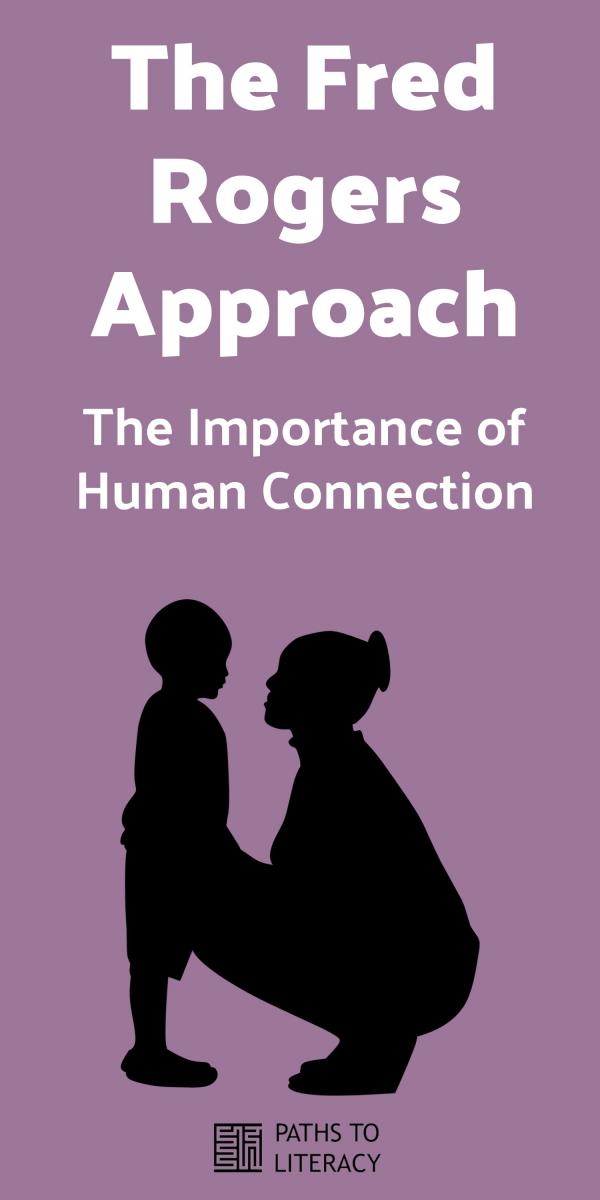The Fred Rogers Approach: The Importance of Human Connection
 “I don’t think anyone can grow unless he’s loved exactly as he is now, appreciated for what he is rather than what he will be.” – Fred Rogers
“I don’t think anyone can grow unless he’s loved exactly as he is now, appreciated for what he is rather than what he will be.” – Fred Rogers
We had early snow in Denver this past school year. The lesson that inspired this post occurred months before we were all homebound, providing remote instruction to students. As a parent, I have struggled with balancing my work while supporting my own kids’ through their remote learning activities. While I have found that my students’ families have been kind and understanding, I have also felt pressure to provide quality instruction without placing too many additional demands on my students’ families.
I’ve had several conversations with parents of my students about changing perspectives and making meaning out of the daily routines they do in their homes. We can borrow from the early intervention model of routine-based intervention to help our students and their families make meaning of the simple materials that are in their home. There are many interesting posts on Paths to Literacy about suggestions for remote learning activities. Daily walks, photo journals, and simple vocabulary lessons about the items on the dinner table all provide opportunity to teach and reinforce meaningful concepts that we don’t always have time to emphasize when we are rushing to and from school and work activities. I think Mr. Rogers would say that when we connect with others to share an interest in the simple offerings of every day, we grow in many ways.
Remembering That Best Growth Occurs When There Is Something Meaningful and Important for the Child in the Lesson
As I approached the school to provide my itinerant services to a student with visual impairments who also has significant support needs, I worried: It had been an extremely hard week for me and I was feeling somewhat ill prepared for my lesson time. I had gathered a book and a bag with some objects to present the story to Lindsay, but I had not spoken with her teacher in a couple of weeks. More importantly, I had not connected with Lindsay in several weeks.
Sometimes when I have new students with complex needs and large educational teams, I feel pressure: I feel that people often look to me for answers. For many children, and especially those who have CVI, there is an intense focus on presentation methods: what is the best lighting, colors, materials, and positioning? With so many assessments and various special education providers, it can become easy to get hung up on accommodations and data collection.
On this day, I was reminded that the best growth occurs when there is something meaningful and important for the child in the lesson.
The Importance of Spending Time Together and Sharing Experiences
When I entered the building and classroom, I was still thinking about what I had in my bag (my iPad ready to play the animated version of The Snowy Day by Jack Ezra Keats, a white board and black marker, a stick, a red hat, and my cardigan with pockets) and how I would make it interesting for Lindsay. I gathered a snowball from the pile outside the school door and I placed it into my zip lock bag. As I sat next to Lindsay, I greeted her and asked her how she was doing. Lindsay communicates with smiles, eye gaze, kicking, large head nods. I responded and gave her feedback. (The team is working on developing a consistent communication system to support Lindsay’s expressive communication skills: like many of our students, especially those who transfer in/are new to us, are very young, it takes a little while to get to know the child.)
As I engaged Lindsay in conversation with simple words and wait time, something shifted in me. I relaxed. I told Lindsay that I had been feeling stressed and worried that she would not find my lesson materials interesting or engaging. As she looked at the items and I guided her elbow to touch them, we talked about what the items are, and what they are used for.
I played the story and guided Lindsay’s feet to point her toes in and out (like the boy in the story). Her feet made crunchy sounds against my paper bag as we listened about the boy making crunchy footsteps in the snow. We explored reaching the stick high up in the air and tapping the wall like it was the snow-covered tree. Lindsay kicked her feet as we tapped the stick against the wall. I took out a little snow and placed it on our heads like the boy in the story experienced. We both winced at the feeling of the cold snow against our heads. I took the snow-ball and placed it into the pocket of the sweater and we felt how it began to melt. As the snow melted, I shared that I was feeling silly to have been worried about the lesson because what I really enjoyed most was sharing stories and experiences with her. I was reminded (and told her) that it is important to spend time together, sharing experiences like we had done with the story and talking.
The Human Connection: Developing a Relationship with the Child
While I was walking back to my car, it occurred to me that when I relaxed, my lesson had turned out very similar to some things I have seen on episodes of Mr. Rogers. Mr. Rogers paced his speaking for children; he provided wait time, presented simple and meaningful materials to children and spent time discussing and exploring these things. From music to feelings to occupations and industry, Mr. Rogers simplified complex constructs into their most meaningful components. One reason Mr. Rogers was successful was because he focused on human connection and letting children know that they are important, just as they are. Mr. Rogers presented interesting things to children in simple ways. Mr. Rogers made simple things interesting!
This reflection reminded me that we gain educational leverage when our students desire to communicate, want to look at something we have to share, and experience something with us (not for us). I am a successful teacher when a student is interested in attending and learning with me. When a student is engaged, they are more likely to reach their educational goals and make growth on the ratings scales that we discuss at IEP meetings. Leverage, interest, and student buy-in are necessary for a successful teaching and learning cycle.
As I continued to think about Mr. Rogers, it occurred to me that the best lessons that I’ve had with students who have significant support needs have been the lessons where the main intention of my time is to get to know the child better. Showing a student that I find them important enough to share something with them opens up so many possibilities: I can give a lesson on my feelings, my morning with my own children, what’s in my lunch box, my bad hair day, my messy purse, my personal need to get some exercise or fresh air… the topics and possibilities are endless.
Of course, there are goals and objectives, but I believe I am more successful in helping students reach objectives when I make the space to form a relationship with the child. This simple method starts by sharing time and letting the student know that they are important to me. When I facilitate and share experiences with my students, I show them that I am interested in watching them learn and grow. I can reflect on how I see them learning, and let them know that their learning is important to me.
As Mr. Rogers demonstrated, I can show my students that people use many different ways to communicate, and that all ways are important: songs, dance, art, facial expressions, written stories, and body movements. It is critical that our students understand that people use many and varied ways to communicate and that each of these ways are special, important, and valuable.
Considering how Mr. Rogers might approach a lesson with my students helped me brainstorm years’ worth of possibilities within a few minutes. Itinerant teaching can be complex; sometimes there is space between visits and services, and educational team dynamics differ throughout schools and communities. This brainstorm session reminded me that itinerant teaching can also be powerfully meaningful when we keep it simple.
I make myself important to my students by showing them that they are important to me, and that their way of learning is beautiful and meaningful. Isn’t that precisely what Mr. Rogers did with his guests and many generations of engaged audience members?



